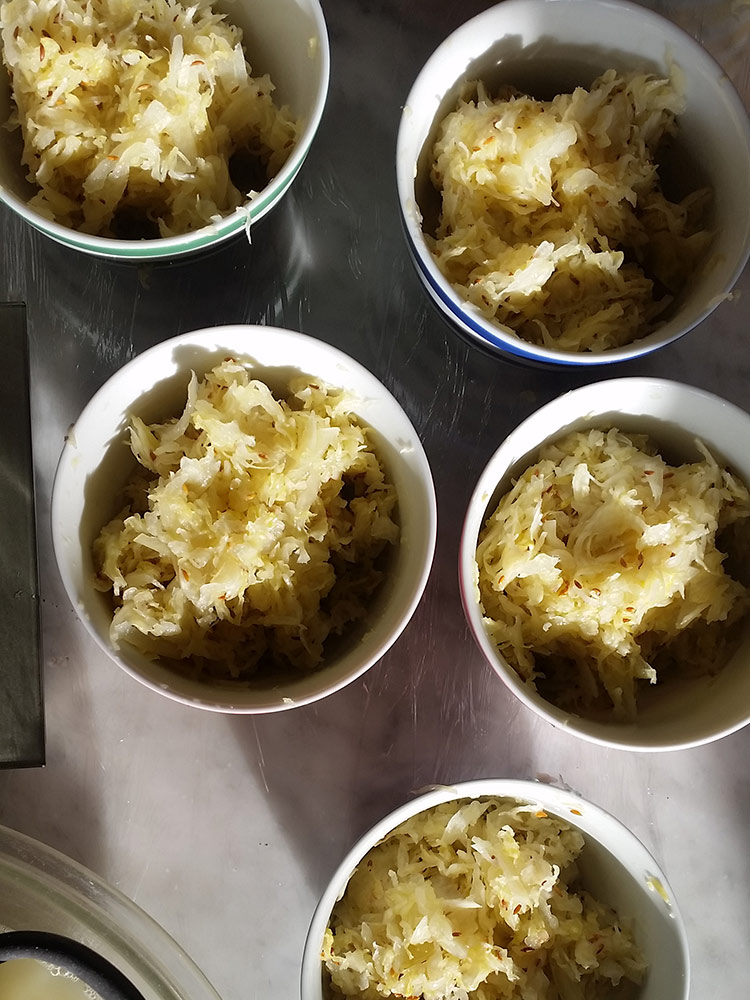zeLi! founder, Vrati Smida, shares his traditional recipe for making your own nutritious and delicious sauerkraut at home – and how to eat it!
Vrati’s recipe is traditional, old school, he says. “The kraut tastes like it ought to, with the texture, flavour and health benefits it should have. The biggest difference between zeLi! and other sauerkraut on the market here is that I don’t use any starter cultures or vinegar. It is raw, unpasteurised, nice and crunchy and hand made in small batches.”
Here are some of Vrati’s favourite ways to incorporate sauerkraut into your meals to reap the benefits of those gut-loving good bacteria:
- Start with my classic kraut on the side of scrambled eggs in the morning, or try a sandwich with poached chicken and zeLi’s ‘East meets West’ (ginger, coriander, lemongrass) for lunch. Any flavour is also perfect on toast with avocado, any time of the day. I highly recommend using great bread from an artisan baker like The Crafty Baker – it takes it to a whole new level.
- Secondly, fish burgers with chilli kraut are awesome. You can use halloumi as an alternative. For a fast and nutritious meal, poach an egg and have it on toast with my ‘Orange to Goodness’ – if you like turmeric, this is sensational.
- Traditionally, kraut would accompany steaks, sausages, roasted and barbequed meats. We also love to eat it by itself as a snack.
- And if you’re that little more health conscious, kraut is great to have on hand. Two to three spoonsful will satisfy hunger without the calories of fruit, and all the benefits, plus some!
- Chicken? Try roasting a chicken in a covered dish with a bag of my zeLi! under it and a sprinkle of paprika on top. Awesome.
- And for a starter or to entertain guests – add some zeLi! to your antipasto platter when you’re having a few Czech beers (if I have Pilsner Urquell and zeLi! it’s a tasty reminder of home).

Vrati’s traditional sauerkraut recipe
Ready in 14 days, this recipe makes approximately 1kg of sauerkraut, which lasts in the fridge for up to two months.
You will need:
• 1kg cabbage (green or red)
• 30g of Himalayan salt
• 7g of fresh caraway seeds
• 1 bay leaf, whole (alternatively you can use juniper or grape leaf)
• 1 x large 1.5 litre glass sealable vessel – a jam jar works well. You can purchase from any home and kitchen store, for example Stevens, The Homestore, Briscoes.
• 1 x smaller glass jar – please ensure this fits inside the neck of larger jar.
Method:
1. Shred cabbage on a mandolin slicer or cut fine with a knife.
2. Place in a mixing bowl, sprinkle salt and caraway over the cabbage. Massage in.
3. Let the cabbage sit for five minutes to allow the salt and caraway to infuse.
4. Capture cabbage juice by squeezing the cabbage over a separate bowl. Repeat two to three times or until no more juice is released.
5. Mix in the bay leaf to cabbage.
6. Pack cabbage into large glass vessel until ¾ full. When filling, place a plate or bowl under the vessel to catch overflow of juices.
7. Fill smaller glass jar with water, press inside the neck of larger vessel until the juice rises above the cabbage, about 3 to 4cm from the top.
8. Juice will overflow, place a plate or bowl beneath to catch any overflow juice.
9. Store juice in the fridge for later.
10. Seal the vessel and store in a dry, dark place – no more than 20 degrees in temperature. A hot water cupboard or pantry is preferable which enables easy monitoring.
11. After four days, the PH level will drop and will require more juice to be added. Take the juice from the fridge and fill vessel until the kraut is submerged.
12. Store for another 10 days.
13. Remove the smaller water jar and store in fridge – for space, you can store in smaller jars and seal with cling wrap and rubber band.
14. Refrigerate and enjoy. Kraut will last up to two months.











